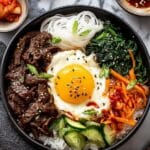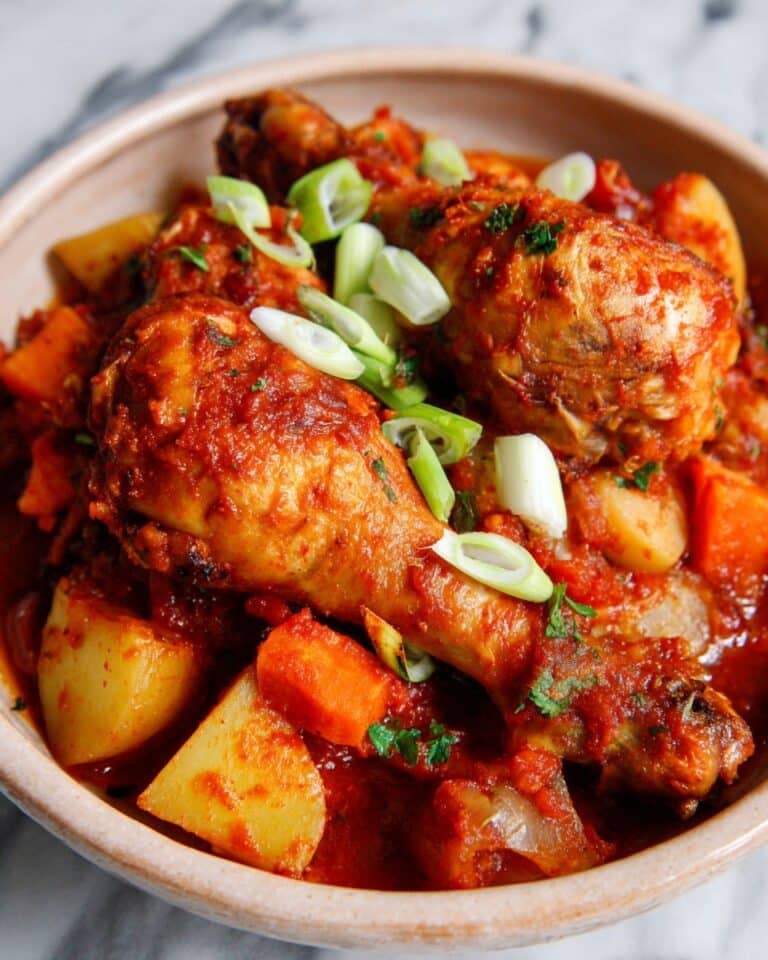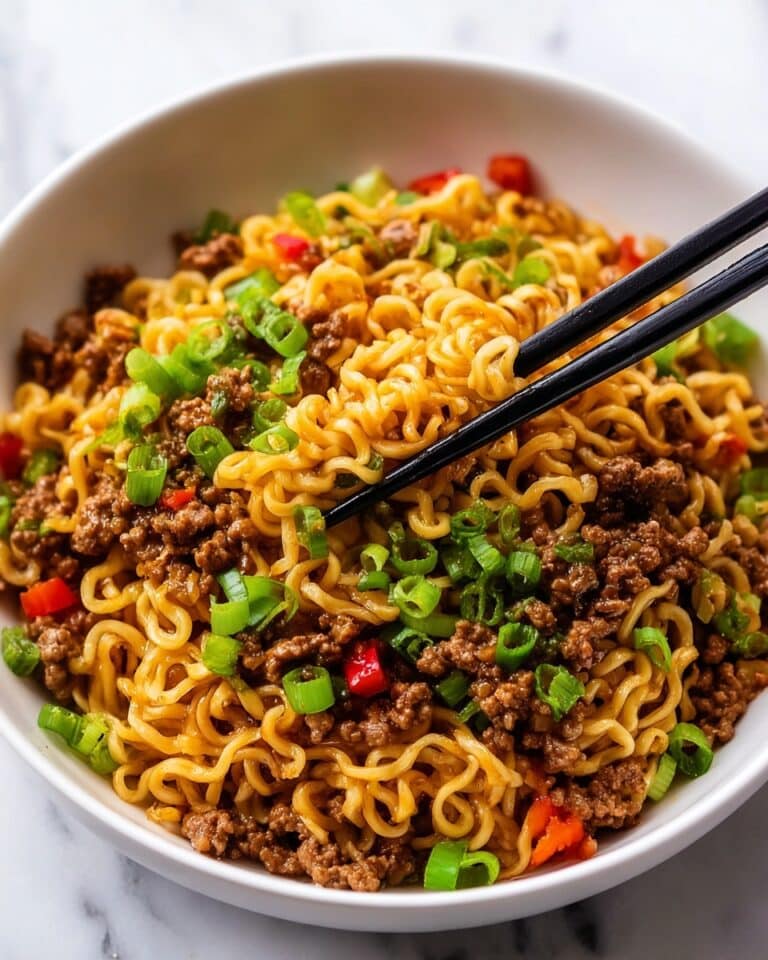Korean Beef Bibimbap Bowl Recipe
If you crave a dish that bursts with vibrant colors, bold flavors, and comforting warmth, then the Korean Beef Bibimbap Bowl Recipe is exactly what you need in your kitchen rotation. This iconic Korean meal blends perfectly seasoned ground beef, fresh sautéed vegetables, and a fried egg atop silky white rice, all tied together with the spicy-sweet kick of gochujang sauce. It’s a harmonious balance of textures and tastes that’s as fun to assemble as it is to devour. Whether you’re cooking for family or entertaining friends, this recipe promises a delicious adventure that anyone can master!
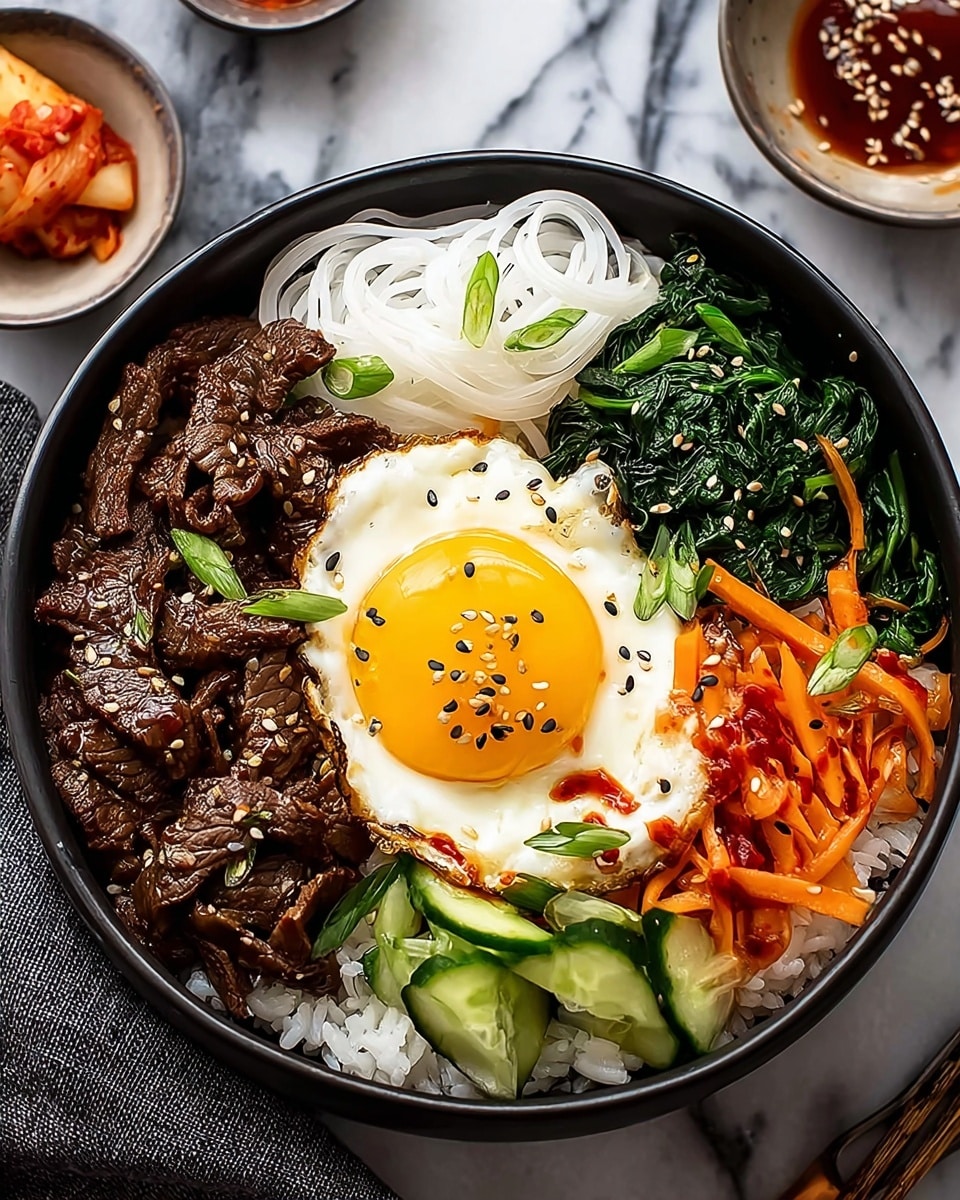
Ingredients You’ll Need
Each ingredient in this Korean Beef Bibimbap Bowl Recipe plays a crucial role, from the tender ground beef offering hearty protein to the crisp vegetables contributing fresh texture and color. The combination creates a dish that is not only satisfying but visually delightful.
- 1 lb lean ground beef: Provides savory, rich flavor with a leaner option to keep the dish balanced.
- 2 cups short-grain white rice (cooked): The soft, sticky base that holds all the delicious toppings together perfectly.
- 1 cup carrots (julienned): Adds a subtle sweetness and a vibrant splash of orange to the bowl.
- 1 cup spinach (fresh): Delivers fresh color and a gentle earthiness, helping balance the spice.
- 1 cup zucchini (sliced): Offers a tender bite and mild flavor that contrasts beautifully with the beef.
- 1 cup bean sprouts: Brings a pleasant crunch and a hint of nuttiness to the dish.
- 3 tbsp gochujang sauce (adjust for spice level): The star element, providing that signature bold, spicy, and slightly sweet kick.
- 1 tbsp sesame oil: Adds a toasty, aromatic layer that elevates the overall flavor.
- 2 tbsp low-sodium soy sauce: Enhances the umami depth without overpowering the other components.
- 4 eggs: Fried sunny-side up to crown each bowl with silky richness.
How to Make Korean Beef Bibimbap Bowl Recipe
Step 1: Prepare the Rice
Start with cooking the short-grain white rice according to the package instructions. The rice should be fluffy and sticky enough to hold the ingredients in place but not mushy. Set it aside and keep warm while you prepare everything else. This creates the perfect foundation that brings all the flavors together.
Step 2: Cook the Ground Beef
In a skillet over medium-high heat, brown the lean ground beef for about 5 to 7 minutes, breaking it apart as it cooks. Once browned, drain any excess fat to prevent greasiness. Adding low-sodium soy sauce, gochujang sauce, and a drizzle of sesame oil, let the mixture simmer on low heat for 5 minutes. This step infuses the beef with that irresistible Korean-inspired umami and spice that defines the dish.
Step 3: Sauté the Vegetables
In a separate pan, heat a bit of sesame oil and sauté the julienned carrots, fresh spinach, sliced zucchini, and bean sprouts together. Cook them until tender-crisp, which takes around 7 minutes. The vegetables add color, crunch, and freshness, balancing the richness of the meat and the heat of the gochujang sauce.
Step 4: Fry the Eggs
Fry each egg sunny-side up in a non-stick pan until the whites are fully set but the yolks remain deliciously runny. This creamy egg topping brings a luscious texture contrast when mixed into the bowl and helps mellow the spicy gochujang flavor.
Step 5: Assemble the Bibimbap Bowls
Now comes the fun part — layering! Start by spooning the warm rice into individual bowls. Top with the spicy beef mixture, followed by the vibrant sautéed vegetables artfully arranged around the edges. Finally, gently place a fried egg on top and add an optional extra drizzle of gochujang sauce if you love it fiery. Watch as the colors and aromas come alive, inviting you to dig in.
How to Serve Korean Beef Bibimbap Bowl Recipe
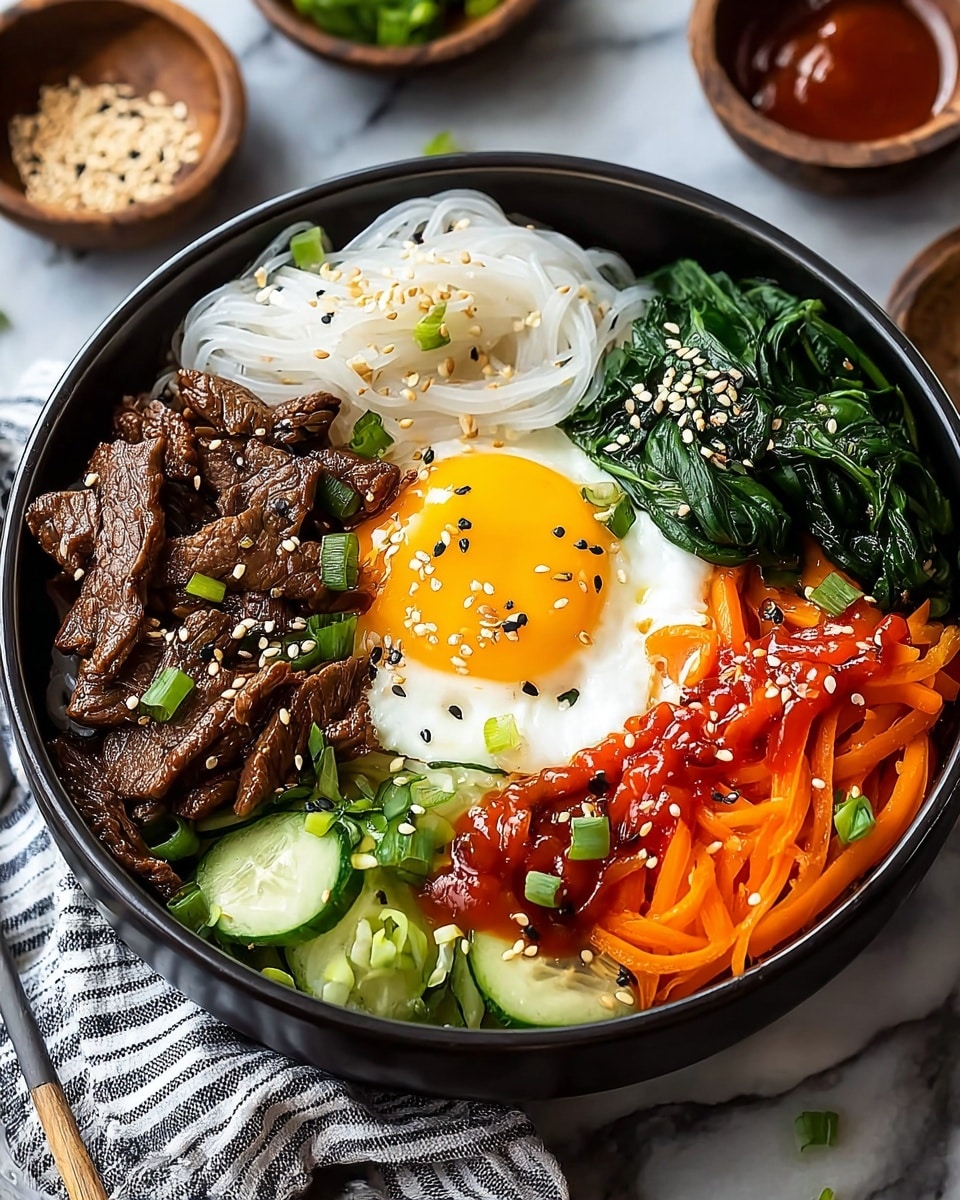
Garnishes
Enhance your Korean Beef Bibimbap Bowl Recipe with garnishes like toasted sesame seeds or thinly sliced green onions. These little additions contribute a pleasant crunch and fresh bite, adding that extra touch of authenticity and appeal that makes the experience even more special.
Side Dishes
Complete your meal by pairing the bibimbap with classic Korean side dishes such as kimchi, pickled radishes, or a simple cucumber salad. These cool, tangy sides contrast beautifully with the warm, spicy bowl and help cleanse the palate between bites.
Creative Ways to Present
For a unique twist, try serving your Korean Beef Bibimbap Bowl Recipe in stone pots (dolsot) to give the rice a crispy crust layer or arrange each vegetable topping in neat sections for a photogenic presentation. You can even experiment by adding avocado slices or crispy seaweed to customize the bowl to your taste.
Make Ahead and Storage
Storing Leftovers
Leftover Korean Beef Bibimbap Bowl ingredients can be stored separately in airtight containers in the refrigerator for up to 3 days. Keeping the components separate helps maintain their textures — rice won’t get soggy, and vegetables stay fresh.
Freezing
Freezing the assembled bibimbap bowl is not recommended because the fresh vegetables and fried egg lose their texture. However, you can freeze the cooked ground beef and rice in portioned containers for up to one month, thawing them gently before reheating.
Reheating
Reheat refrigerated leftovers by microwaving the beef and rice mixture until steaming hot. Add fresh sautéed veggies if you have them, and top with a freshly fried egg to recreate that just-made yumminess to enjoy your Korean Beef Bibimbap Bowl Recipe all over again.
FAQs
Can I use other types of rice for this recipe?
While short-grain white rice is traditional and ideal because of its sticky texture, you can substitute with medium-grain rice. Just avoid long-grain varieties like basmati as they won’t hold the bowl’s components together as well.
How spicy is the gochujang sauce?
Gochujang sauce has a mild to medium heat level balanced by sweetness and fermented depth. You can always adjust the amount added to suit your heat tolerance or add a little honey if you want to tame the spice.
Can I make this recipe vegetarian?
Absolutely! Swap the ground beef for firm tofu or tempeh crumbles seasoned similarly with soy sauce and gochujang. Use vegetable broth or just stir-fry the protein alternative for a satisfying vegetarian Korean Beef Bibimbap Bowl Recipe variation.
Is this dish gluten-free?
Traditional soy sauce contains gluten, but you can use tamari or a gluten-free soy sauce to keep this recipe gluten-free without missing out on flavor.
What’s the best way to eat bibimbap?
The classic way is to mix all the components thoroughly just before eating, combining the runny egg and sauce with rice, beef, and veggies for that perfect bite every time.
Final Thoughts
Whipping up this Korean Beef Bibimbap Bowl Recipe is more than just making dinner; it’s an experience filled with vibrant flavors and textures that come together beautifully. It’s comforting, exciting, and incredibly satisfying — a dish that’s bound to become a favorite in your home just as it is in mine. So, gather your ingredients, get your pans ready, and dive into this delicious Korean adventure tonight!
PrintKorean Beef Bibimbap Bowl Recipe
This Korean Beef Bibimbap Bowl is a vibrant and flavorful dish featuring seasoned ground beef, fresh sautéed vegetables, and a perfectly fried egg served over steamed short-grain rice. Enhanced with spicy gochujang sauce and sesame oil, it brings a balanced harmony of textures and bold Korean flavors to your table in about 50 minutes.
- Prep Time: 15 minutes
- Cook Time: 35 minutes
- Total Time: 50 minutes
- Yield: 4 servings 1x
- Category: Main Course
- Method: Stovetop
- Cuisine: Korean
Ingredients
Protein
- 1 lb lean ground beef
- 4 eggs
Grains
- 2 cups short-grain white rice (cooked)
Vegetables
- 1 cup carrots (julienned)
- 1 cup spinach (fresh)
- 1 cup zucchini (sliced)
- 1 cup bean sprouts
Sauces & Oils
- 3 tbsp gochujang sauce (adjust for spice level)
- 1 tbsp sesame oil
- 2 tbsp low-sodium soy sauce
Instructions
- Cook the Rice: Prepare the short-grain white rice according to the package instructions. Once cooked, set it aside, keeping it warm for assembling the bowls later.
- Brown the Ground Beef: Heat a skillet over medium-high heat and add the lean ground beef. Cook for 5-7 minutes, stirring occasionally, until fully browned. Drain any excess fat to keep the dish lean.
- Season the Beef: Stir in the gochujang sauce, low-sodium soy sauce, and sesame oil into the browned beef. Lower the heat to simmer and cook gently for 5 minutes, allowing the flavors to meld.
- Sauté the Vegetables: In the same or a separate skillet, heat some sesame oil over medium heat. Add the carrots, spinach, zucchini, and bean sprouts. Cook for about 7 minutes, stirring occasionally, until the vegetables are tender-crisp but still vibrant.
- Fry the Eggs: In a clean non-stick skillet, fry the eggs sunny-side up over medium heat. Cook until the egg whites are set but the yolks remain runny, approximately 3 minutes.
- Assemble the Bibimbap Bowls: To serve, divide the cooked rice among four bowls. Layer the simmered beef mixture over the rice, add the sautéed vegetables alongside, and top each bowl with a freshly fried egg. Drizzle additional gochujang sauce over the top if desired for extra heat and flavor.
Notes
- Adjust the amount of gochujang sauce according to your preferred spice level.
- Using lean ground beef keeps the dish healthier and less greasy.
- For a vegetarian version, substitute beef with seasoned tofu or mushrooms.
- Leftovers can be stored in the refrigerator for up to 3 days; reheat gently before serving.
- Serve with kimchi or pickled vegetables to add extra traditional Korean flavors.
Keywords: Korean beef bibimbap, bibimbap bowl, Korean rice bowl, ground beef recipe, gochujang sauce dish, Korean cuisine, healthy Korean dinner

